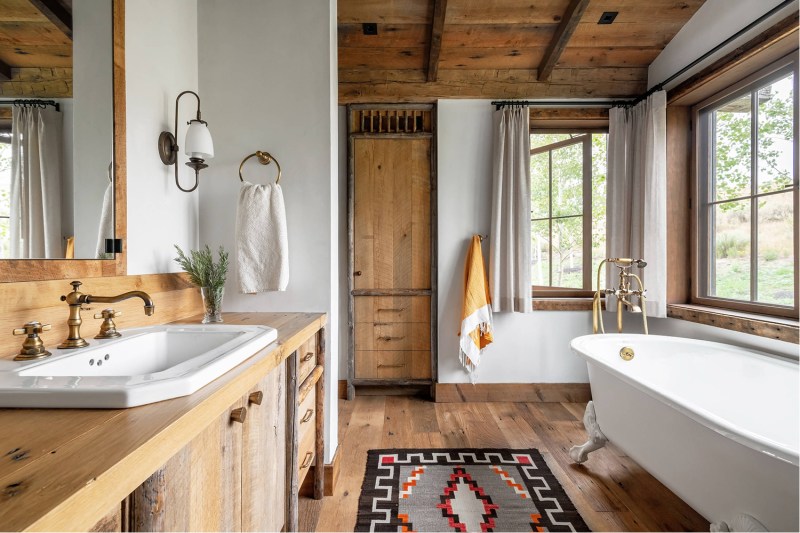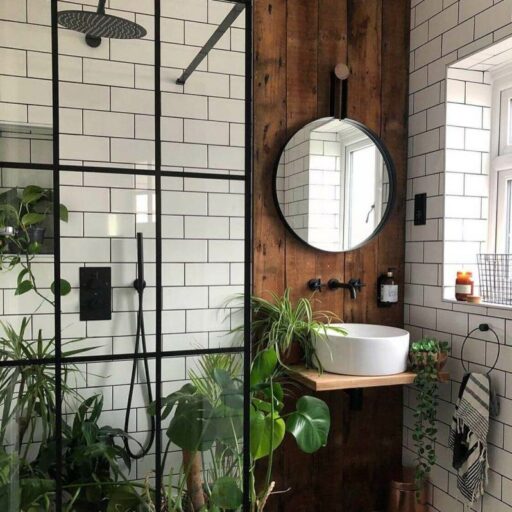Adding A Bathroom To An Old House – Think of it as the equivalent of an open-plan kitchen: removing walls to create a wide sight line. The bathroom provides light and air for a luxurious space. It can combine shower and bath in a watertight area with a glass panel or be completely watertight. All furniture can be arranged in an obstruction-free configuration. With no walls separating the bath and shower, and no shower curtain or walk-in shower, a wet room approach can make the space appear larger. “It makes the shower experience better because you’re not trapped behind a glass box,” says San Francisco architect John Lum, who has designed more than a dozen wet rooms for clients.
Although easiest to design and build from scratch, a wet room can also be a retrofit option. “If you have a small space and want to shower, a wet room makes a lot of sense,” says Matthew McHenry, a construction manager in Berkeley, California. The traditional wet room, long found in European homes, is the bathroom; pool A completely watertight area with a toilet and often a bath. It is usually small, with a tiled ceiling in the middle of the room, walls and a sink and toilet hanging from the wall. More common today is a wet room, where the shower and bath share wet space at the far end of the room, with the sink and toilet surrounded by glass enclosures. Popup: See what planning is needed for this type of open bathroom.
Adding A Bathroom To An Old House
Separated from the bath and shower by a glass screen, the wooden tray screen keeps towels dry and ready on an easy-to-access open shelf. |
Small Bathroom Ideas With Vintage Decor
Start with the tub and sink, if there is one. Turning the wet room into a focal point. Designers often place the bathroom on the back wall and in front. Alternatively, the bath and shower can be placed opposite each other on the side walls. Best of all, bathrooms should have at least 3 feet 36 inches of space on either side of the tub.
If possible, place the shower outside of the splash zone so the water can flow without getting soaked. Because the shower spray pattern can expand up to 6 feet in diameter; A glass frame or front screen is often used to surround the sink and toilet. It can be hinged or supported, but is usually flush with the floor or curtain. In larger bathrooms, the mirror can be two panels with a door in the middle and a door to the wall – and to the ceiling if you have a steam unit – or an open door.
It comes with a water spray and keeps the large area cooler. Place the sink on the same wall as the bathroom. So direct the water away from it. Splash protection can use a kit;
Protection from direct shower is required. in a damp room; A porcelain pedestal or wall-mounted sink is very resistant to moisture. Nobody likes a wet toilet seat. Therefore, if space allows, consider placing it as far away from the shower head as possible. The wall-mounted toilet makes cleaning easier, especially in a wet bathroom. Store towels (and toilet paper) on a shelf or in a closet away from the bathroom. Attach a hook out of reach of the shower jet to keep the towel close at hand, or hang it near the entrance to the wet area to keep it high and dry.
Vintage Bathroom Ideas With Retro Decor
A rail head that flows into the drain instead of out reduces the width of the sprinkler. |
Working with the orientation of existing floor joists will avoid significant cutting for remodeling or bathroom floor plumbing. You want to install the drain body between the joists and with a linear drain it allows the space to run parallel to the joists. The wall drain location (page 64) must be calculated at the base of the shower wall. for starters The floor should be square and level to facilitate drainage and reduce settlement, and have sufficient structural strength – a wet room can be significantly heavier than a normal bathroom.
“On a large house, you may want to cut the joists down to code and space them 16 inches on center to make sure your structure is strong,” says veteran surveyor Joe Cannato. The floor in a wet area should have a slope of at least 1/4 inch per foot to direct water to the drain. Code requires drains to be at least 2 inches below the highest point of the floor. If the wet room is to be further integrated, the floor structure can be built to accommodate the plumbing from the ground up. Some contractors go the extra mile with more durable wood.
“Whether we’re building or renovating, we like to use marine lumber everywhere,” says Seattle contractor Jim Doe, less likely to rot the frames that way. Doe said.
Cabin Bathroom Ideas For 2024
Left: A marble ceiling slab protects the walls (and floor) in this wet room, along with herringbone rails on the walls above as a storage strip. |
Unenclosed wet areas flow seamlessly from the rest of the bathroom, creating an elegant, open space that is fully accessible to aging homeowners. In the bathroom with a partition. sink The floor under the toilet and bath is sloped to the drain area in the shower area. In a wet room without a bath or central drain. Again, they tend to be on the smaller side – the floors slope in all directions; Suspended sinks and toilets are a practical option.
Here’s the problem: whether you add a thin pre-slide tray made of polyurethane to the rest of the room and the wet floor, the base has to be lowered to slope down to the shower. Foam or solid plastic or custom car bed. If the joints in an older house are fleshy enough. You can shave a few inches off the tips and sand them down to get the structural strength you need. If not, the wet area floors may need to be changed to lower levels.
A tall curtain at the entrance to the wet area, which contains the tub and shower, helps collect water.
Home Improvement Ideas On Budget
Prevents leakage to internal and surrounding areas. It’s easier and cheaper to renovate a bathroom floor because you can create space for drainage and plumbing to slope the shower floor. The curb may be sized so that its top is at least 2 inches above the drain. Weaknesses? It looks messy and can be a challenge for people with mobility issues.
Kerdi (schluter.com) waterproofing membrane layers are installed over a thin layer of mortar and then covered with thinner layers to reach the tile. Sealing tapes along the seams and joints of the floor and walls provide a watertight seal. |
Since glazed tiles are permeable to water, a wet area requires a fully waterproof underlay. Most contractors today use foam board for waterproofing floors and walls. Bonded membranes and some liquid membranes are used to waterproof floors and walls, even over traditional plasterboard and cement wallboard. These products are often used together in various combinations.
: Conventional siphons are the ideal and most affordable option for most wet rooms. The drain is usually located near the center of the wet area or near the floor of the entire wet room. You can move it closer to the shower head to catch the water better or slightly off-center to avoid feeling underfoot. Square gutters simplify tile installation with less cutting than round gutters. Some adopt open-to-circle panels for a seamless look.
The Pros Guide To Renovating A Bathroom
At least once a year: If the water changes color while wet, it’s time to repot. Don’t wait to replace cracked panels and missing soap. Both leak water and damage the underlying layers.
Left: Colorful mid-century-inspired tiles cover the bathroom’s accent wall and backsplash, providing the focal point of a modern wet room complete with sleek finishes and accents. |
. Right: Even the ceiling is covered with reddish-brown waterproof plaster in a small wet room. The decorative texture on the floor of the wet area provides additional slip resistance. |
However, tiles are a useful option for walls in wet rooms. Designers are stone slabs, other materials are included, including metal sheets and waterproof plaster. “Tadelakt is a handmade limestone plaster,” says Los Angeles architect John Hamilton, who is often in demand.

